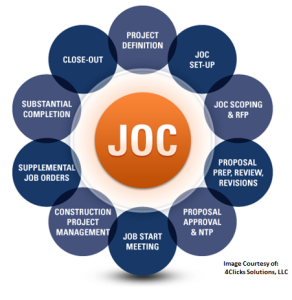@All,
JOC, like any other successful AECOO activity, requires experience, collaboration, and transparency in order to succeed.
JOC is an efficient and widely practice method for both Owners and Contractors to manage their numerous common repair, renovation, and maintenance construction projects. These types of projects represent the majority of dollars spent for most Owners and the trend will continue.
Experience – One must be an experienced estimator and experienced RSMeans, or any RSMeans-based JOC. Experience in BOTH of is a prerequisite for the Owner and Contractor. Knowledge of RSMeans line item estimating (not square estimating) and what each line item contains, as well as the associated use of the CCI (city cost index) and co-efficients is the level of knowledge “standard”.
Collaboration – Not all owners and contractors are suitable JOC, or even more specifically an RSMeans JOC. Both need to have sufficient experience in estimating, construction, teaming, and be willing to truly share information. Joint site walks and scoping common. A reasonable profit, quality, and projects complete on-time and on-budge, and long term relationships are the goal. An alternative, of course, for an Owner to “outsource” your JOC. In this case, an Owner pays a fee to have a third party administer their JOC program. There are obvious pros and cons of outsourcing. Outsourcing any facilities aspect is a strategic decision, and one not to be taken lightly, especially if facilities are core to an organization’s mission.
Transparency – The RSMeans (or any good UPB) provides the ability to rapidly gain insight into job scope. Custom line items can easily be constructed and are built into the same data architecture (MasterFormat) and tagged accordingly. They can later be added to the UPB.
Some of you reading this may have had previous and even significant experience with JOC, UPBs (Unit Price Books- custom, national, regional, and custom), as well as other forms of Integrated Project Delivery (IPD), and all of us are still learning each and every day.
If you would like to learn more visit jocexcellence.org, 4clicks.com… and I can provide other informational sources. There are multiple case studies, white papers, and research documents. A national JOC study is also currently underway. It’s being sponsored the Center for JOC Excellence, our firm and others, and run by ASU.
A few other items:
Most JOCs require the use of RSMeans and specifically “bare costs” and the Facilities Cost Book. With the acquisition of RSMeans by the Gordian Group, there has been some indication that the Gordian Group is beginning to market RSMeans for construction cost estimating only, and the CTC for JOC. As one does actually construction cost estimate for JOC, the distinction may be causing confusion for some. Nonetheless, any construction cost unit price book can be used that is appropriate for both the Owner and Contractor. There are a wide range of construction cost resources available, thus any decision in this regard should be made after researching the market and matching available options with your specific needes.
Bare costs do not include contractor’s overhead(s) and profit.
Estimating JOC projects and/or bidding JOC contracts requires many of the same considerations as a non-JOC situation”
- Average size projects
- Annual volume
- Competition
- Type of work
- Site conditions / site access
- risk(s)
- work complexity
- Labor type, availability, productivity
- Time of year
- General requirements:
General Requirements: managers, site trailers, schedule management, quality control, daily clean up, security, safety, communications, computer software…
Overhead: home office related costs…
Profit:


